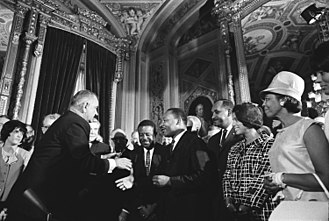Voting Rights Act of 1965





The Voting Rights Act of 1965 is a landmark piece of federal legislation in the United States that prohibits racial discrimination in voting. It was signed into law by President Lyndon B. Johnson on August 6, 1965, and Congress later amended the Act five times to expand its protections. Designed to enforce the voting rights guaranteed by the Fourteenth and Fifteenth Amendments, the Act is considered one of the most far-reaching pieces of civil rights legislation in U.S. history.
Background[edit]
The Voting Rights Act of 1965 was enacted during the height of the Civil Rights Movement. Despite the Fifteenth Amendment, which was ratified in 1870 and prohibited states from denying a male citizen the right to vote based on "race, color, or previous condition of servitude," various discriminatory practices were used to disenfranchise African Americans, particularly in the Southern United States.
Key Provisions[edit]
The Act contains several key provisions:
- Section 2: A general prohibition on voting discrimination.
- Section 4(b): Establishes a formula to identify areas where racial discrimination in voting had been prevalent.
- Section 5: Requires jurisdictions identified by the Section 4(b) formula to obtain federal preclearance before implementing any changes to their voting laws or practices.
- Section 6-9: Authorizes the appointment of federal examiners and observers to monitor elections.
Impact[edit]
The Voting Rights Act of 1965 had an immediate and significant impact on voter registration and participation. In the years following its enactment, the number of registered African American voters in the South increased dramatically. The Act also paved the way for greater representation of minorities in elected offices.
Amendments and Legal Challenges[edit]
The Act has been amended several times to expand its protections. Notable amendments include the Voting Rights Act Amendments of 1970, which extended the ban on literacy tests, and the Voting Rights Act Reauthorization and Amendments Act of 2006, which extended the Act's key provisions for another 25 years.
In 2013, the U.S. Supreme Court case Shelby County v. Holder invalidated the Section 4(b) coverage formula, effectively gutting the preclearance requirement of Section 5. This decision has led to renewed debates over the necessity and scope of the Voting Rights Act.
Legacy[edit]
The Voting Rights Act of 1965 is widely regarded as a pivotal moment in the struggle for civil rights in the United States. It has been instrumental in reducing barriers to voting for minority groups and ensuring a more inclusive democratic process.
See Also[edit]
- Civil Rights Act of 1964
- Fifteenth Amendment to the United States Constitution
- Fourteenth Amendment to the United States Constitution
- Shelby County v. Holder
- Civil Rights Movement
References[edit]
<references group="" responsive="1"></references>
External Links[edit]
Ad. Transform your life with W8MD's Budget GLP-1 injections from $75


W8MD offers a medical weight loss program to lose weight in Philadelphia. Our physician-supervised medical weight loss provides:
- Weight loss injections in NYC (generic and brand names):
- Zepbound / Mounjaro, Wegovy / Ozempic, Saxenda
- Most insurances accepted or discounted self-pay rates. We will obtain insurance prior authorizations if needed.
- Generic GLP1 weight loss injections from $75 for the starting dose.
- Also offer prescription weight loss medications including Phentermine, Qsymia, Diethylpropion, Contrave etc.
NYC weight loss doctor appointmentsNYC weight loss doctor appointments
Start your NYC weight loss journey today at our NYC medical weight loss and Philadelphia medical weight loss clinics.
- Call 718-946-5500 to lose weight in NYC or for medical weight loss in Philadelphia 215-676-2334.
- Tags:NYC medical weight loss, Philadelphia lose weight Zepbound NYC, Budget GLP1 weight loss injections, Wegovy Philadelphia, Wegovy NYC, Philadelphia medical weight loss, Brookly weight loss and Wegovy NYC
|
WikiMD's Wellness Encyclopedia |
| Let Food Be Thy Medicine Medicine Thy Food - Hippocrates |
Medical Disclaimer: WikiMD is not a substitute for professional medical advice. The information on WikiMD is provided as an information resource only, may be incorrect, outdated or misleading, and is not to be used or relied on for any diagnostic or treatment purposes. Please consult your health care provider before making any healthcare decisions or for guidance about a specific medical condition. WikiMD expressly disclaims responsibility, and shall have no liability, for any damages, loss, injury, or liability whatsoever suffered as a result of your reliance on the information contained in this site. By visiting this site you agree to the foregoing terms and conditions, which may from time to time be changed or supplemented by WikiMD. If you do not agree to the foregoing terms and conditions, you should not enter or use this site. See full disclaimer.
Credits:Most images are courtesy of Wikimedia commons, and templates, categories Wikipedia, licensed under CC BY SA or similar.
Translate this page: - East Asian
中文,
日本,
한국어,
South Asian
हिन्दी,
தமிழ்,
తెలుగు,
Urdu,
ಕನ್ನಡ,
Southeast Asian
Indonesian,
Vietnamese,
Thai,
မြန်မာဘာသာ,
বাংলা
European
español,
Deutsch,
français,
Greek,
português do Brasil,
polski,
română,
русский,
Nederlands,
norsk,
svenska,
suomi,
Italian
Middle Eastern & African
عربى,
Turkish,
Persian,
Hebrew,
Afrikaans,
isiZulu,
Kiswahili,
Other
Bulgarian,
Hungarian,
Czech,
Swedish,
മലയാളം,
मराठी,
ਪੰਜਾਬੀ,
ગુજરાતી,
Portuguese,
Ukrainian